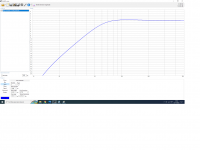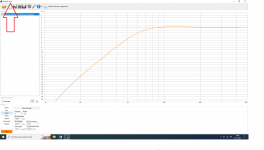I have been thinking if I should alter my plan because of the immense air velocity.Forget flaring, corner loading, etc., at ~35 m/s the vent is already 'choking' and pretty confident that your box will be a near enough sealed alignment at highest powers.
To prove it take a drinking straw and flow just enough water pressure to see it coming out in pulses due to its pipe harmonics and increase pressure till it's just dribbling due to flowing over/around it, but the vent can't be bypassed except by the driver, which of course is pressurizing the box/vent, so at some point it closes up to at best a leaky sealed box alignment and the question becomes; can the driver handle it at low distortion and is the box construction rigid/massive enough?
Frankly, with the ideal pipe size required, really need to make a TL or MLTL depending on the driver's specs and whether or not the driver can actually handle this much power down low, so what brand/model driver and quantity used?
Space is scarce, so a TL or MLTL is also out of the question. I also don't have the space for dual 18" PR:s.
I'm using a custom Sundown NSV3 18" D0.7Ohm.
It has a 90mm long 3" coil and triple 12" spiders. Xmax to 70% Bl should be around 40-45mm one way.
The motor should handle 2500-3000Wrms and 7k-10kW peak. The sub weighs around 50kg.
Currently I only have the front baffle and an air tight trunk, with a 50cm long concrete tube. I modeled the trunk at about 400l.
The amplifier is a Soundigital 8K that producec 8-10kW at 2Ohms
Here is the excursion at 8kW with a 20Hz HPF in the 400l box tuned to 28Hz:
So yes, the driver will withstand almost anything and the motor even has shorting rings etc for lower induction.
Yeah those were some old plans I was trying to think different.Hmm, in searching for driver specs, found this, so being somewhat 'treading on trodden ground', good luck with it.
I did get a Dayton dats v3 and measured the sub after maybe 1-2h of break-in. The Fs has probably lowered a bit still, but these should be close:
1) So you say that I should use 40.28 cm long each tube, correct? Just to make sure, I didn't understand that part about "at least it shows to me". In what, the box is shaded, is that perhaps?1. I think it already has the 0,732 correction, at least it shows to me, that it has. And it gives similar results to other calculators with the same parameters and K.
2. If I understand correctly, you are asking if you can tune the box lower or higher that the Fs of the driver?
You "can" tune the box to whatever you want. You can always tune higher than, or at Fs, if that gives you the response you want, or the box size becomes too big.
If the driver has a "low" Qts, e.g. 0.1 - 0.5 ish, you can tune lower that Fs, as long as the driver doesn't bottom out.
I personally prefer ported and horn loaded subwoofers over sealed, because you just get more, free bass, at little to no cost in sound quality.
2) My doubt is because I have always heard that it should be tuned slightly above the speaker's FS so that, precisely, it does not "discharge".
Thanks again
1. If you are using a round or rectangular port that is not touching a wall, you should be fine with the port length that WinISD gives you.1) So you say that I should use 40.28 cm long each tube, correct? Just to make sure, I didn't understand that part about "at least it shows to me". In what, the box is shaded, is that perhaps?
2) My doubt is because I have always heard that it should be tuned slightly above the speaker's FS so that, precisely, it does not "discharge".
Thanks again
If you are using a slot port that uses the enclosure walls as sides, you should use a calculator where you can specify a higher constant K for the end correction.
2. If you are using a big subwoofer with a "large" round surround and a good amount of Xmax, you can definetly tune at Fs or a bit lower.
If you are using a PA-style subwoofer or a sub with very little Xmax, I would tune at Fs, if you want to tune as low as possible.
If you can add a HPF IRL and simulate the excursion in WinISD to be safe, you can pretty much tune it however you want, but these guidelines are good enough.
Thanks GM1) Already and very dim memory 'says' the 'pro' version might have the option to change it. So many folks are still using it, tempted to reinstall it.
2) Depends on if the difference between the two makes an audible difference, which usually means > ~10% and if this far off might be best to use full measured specs.
1. If you are using a round or rectangular port that is not touching a wall, you should be fine with the port length that WinISD gives you.
If you are using a slot port that uses the enclosure walls as sides, you should use a calculator where you can specify a higher constant K for the end correction.
2. If you are using a big subwoofer with a "large" round surround and a good amount of Xmax, you can definetly tune at Fs or a bit lower.
If you are using a PA-style subwoofer or a sub with very little Xmax, I would tune at Fs, if you want to tune as low as possible.
If you can add a HPF IRL and simulate the excursion in WinISD to be safe, you can pretty much tune it however you want, but these guidelines are good enough.
1) I plan to use round ports as it is in the attachment, you can enlarge it to see the values better. So 2x 16" long, just tell me yes or no, I don't want to clutter up the OP's thread.
2 ) Yes, that is the case, DeltaPro18A, 6.70mm Xmax,15mm Xlim. I only improve 2 Db in F3, but it strikes me that Eminence does not recommend it for sealing, so far it worked perfectly (with DSP) .
Attachments
1. Then the WinISD length should be correct.1) I plan to use round ports as it is in the attachment, you can enlarge it to see the values better. So 2x 16" long, just tell me yes or no, I don't want to clutter up the OP's thread.
2 ) Yes, that is the case, DeltaPro18A, 6.70mm Xmax,15mm Xlim. I only improve 2 Db in F3, but it strikes me that Eminence does not recommend it for sealing, so far it worked perfectly (with DSP) .
2. That driver would need a lot bigger enclosure to really take advantage of being ported. It won't gain much out of a bigger sealed box, but a vented box could be hundreds of liters, because it has such high Vas. If you just want more low end, then porting to 28-30Hz will help, but as you said, not that much in that small of a box. but if you want the most output a 50Hz tune would give you that.
Here is max SPL comparison, there I used 1000W and 6,7mm of Xmax:
You can see that Xmax is the limiting factor in both, but the vent gives more output around the tuning frequency with less excursion.
If you have very little power, a much bigger, ported enclosure would be the way to go.
I appreciate the simulation you've done, thanks. I just want the first octaves as flat as possible, I know I'll have to use DSP anyway to flatten the low frequency curve, because as you say, the VAS is limiting. I'm trying to achieve a little more harmonics (??) by going from sealed to BR.
There is plenty of energy (450 W/Ch) will not be a limitation.
I see that if I use only one tube it will be shallower and easier to locate since it is a prism.
I will open another dedicated thread when I do the experiment to see what changes in the sound down there.
Thanks again!
Sorry OT
There is plenty of energy (450 W/Ch) will not be a limitation.
I see that if I use only one tube it will be shallower and easier to locate since it is a prism.
I will open another dedicated thread when I do the experiment to see what changes in the sound down there.
Thanks again!
Sorry OT
1) Does the length of the tuning tube calculated by WINISD have the 0.732 correction factor already applied, or should we apply it ourselves?
The program automatically applies the end corrections to the physical length shown.
For example in this attachment, I must multiply 40.28 x 0.732 and the actual length will be 29.48 cm? Or is 40.28 already calculated with the correction value?
40.28 cm is the actual physical length of the port tube.
The program adds the end correction lengths as necessary. No need for you to worry about them.
The 0.732 average end correction factor assumes that one end of the port tube is flanged and that the other end is unflanged.
Flanged = 0.850
Unflanged = 0.614
Flanged + unflanged = 1.464
Average = 1.464 / 2 = 0.732
Total end correction = 2 ends * 0.732 * port radius (same as 0.850 * port radius + 0.614 * port radius)
In your example there are two 10 cm diameter ports having a total cross-sectional area of 157.08 cm2
The equivalent radius is therefore 7.07 cm
Total end correction applied = 2 * 0.732 * 7.07 = 10.35 cm
Port tube virtual length used in the simulation calculations = 40.28 + 10.35 = 50.63 cm
Thanks David for clarifying how to get to 0.732. It's not easy to understand everything for a neophyte like me, but I'll keep trying ....🤔 As I said, I'll use only one tube, less work and easier to place. But...WinIsd marks "error" (top left, see attached) which puzzles me. I looked for my old laptop with Win 7 where I had installed WinIsd and copied all the values of the Eminence Delta Pro 18 A speaker (now out of production, they have even changed the web page and I can no longer find the PDFs of various cabinets .) there everything works better, ( no error message on the top left ) and there is information available, such as the graphs of admissible power, maximum SPL, etc. that can be visualized perfectly, not so in the desktop PC I currently use with Win 10.... Something must be wrongly loaded there, I guess I'll have to follow the instructions for loading data to the letter, - I understand that the steps for loading data of the speaker must be followed, so the program calculates the remaining cells. To work ! Thanks again.
Attachments
- Home
- Loudspeakers
- Subwoofers
- How do I lower tuning frequency with the same port?


